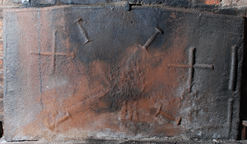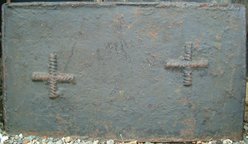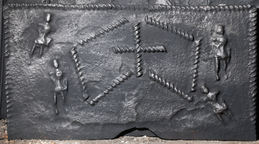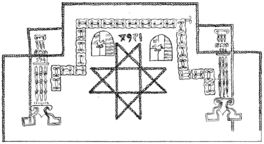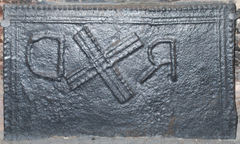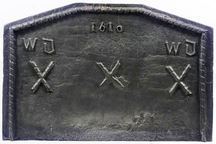-
587
Description: Quasi-rectangular; grooved dowel edging (top and sides); four impressions of a rondel dagger (c.330mm) saltirewise between two dowel crosses; two vertical lengths of dowel in line along right edge.
Notes: Rondel daggers were common in the 15th and 16th century. Grooved lengths of dowel are to be seen on other firebacks suggesting a common source. The arrangement of the daggers (each approx. 35cm long) in a saltire may also have apotropaic significance.
- Decoration tags:
- quasi-rectangular (shape)
- grooved dowel (edging)
- simple stamps
- apotropaic
- objects
Manufactured: in the mid 16th century in the Weald area of England.
Current location: in private hands, Plaxtol, Kent, England.
- Attached to series:
- Grooved dowel series
- Knife & Dagger stamp firebacks
-
602
Description: Canted rectangle; twisted rope edging (top and sides); roughly symmetrical arrangement of two large saltires formed of twisted rope inside and below the top corners, with two small saltires, also of rope, between the large ones and the lower ends of the canting.
Notes: The simple arrangement, while likely to be early, is difficult to date with any precision. Christie's Masters and Makers Sale, South Kensington, 30 Nov 2010, lot 532 (£500).
- Decoration tags:
- canted rectangular (shape)
- rope (edging)
- simple stamps
- apotropaic
- objects
Manufactured: in the 16th century possibly in the Weald area of England.
Current location:, England.
- Attached to series:
- Rope design firebacks
-
615
Description: Rectangular; twisted rope edging (top and sides); two irregularly spaced crosses formed of short, thick twisted lengths of rope.
Notes: The crosses may have been formed by twisting thinner rope around a short length of dowel, and are likely to have Christian significance.
- Decoration tags:
- rectangular (shape)
- rope (edging)
- simple stamps
- apotropaic
- objects
Manufactured: in the 16th century possibly in the Weald area of England.
Current location: Mark Ripley Forge & Fireplaces, Northbridge Street, Robertsbridge, East Sussex, England.
- Attached to series:
- Rope design firebacks
-
628
Description: Rectangular; twisted rope edging (top and sides); twisted rope length stamped eight times in a mirrored double rhombus pattern with a central cross; a crude human figurine stamped irregularly four times, two on each side of the rope design.
Notes: An uncharacteristically small fireback for its likely period.
- Decoration tags:
- rectangular (shape)
- rope (edging)
- simple stamps
- carved stamps
- apotropaic
- objects
Manufactured: in the mid to late 16th century possibly in the Weald area of England.
Current location: Mark Ripley Forge & Fireplaces, Northbridge Street, Robertsbridge, East Sussex, England.
- Attached to series:
- Miscellaneous stamp firebacks
- Figurine firebacks
- Rope design firebacks
-
1015
Description: Rectangular with two-stepped top; twisted rope edging (top and sides); twisted rope extensions enclosing intermediate step with rope continued parallel to sides; central rope octagram with reversed date above between repeated inverted shield shapes off-set (left higher than right); the shield blazon: barry wavy impaling quarterly, overlaid with a small bird stamp and an indistinct ?bird shape in the top left quarter as viewed; within the rope, a roughly parallel arrangement of 23 double-loop-patterned stamps, with the faint impression of an additional stamp in the top right corner of the arrangement; outside the loop stamps and partially overlying the vertical rope extensions, the impressions of two classically designed firedogs with Ionic capitals and fluted pilasters, bearing the date 1594, but with the '1' missing; the fluting on the pilasters has been overlaid by the repeated impression of a turned peg.
Notes: A large and remarkably elaborate fireback: the octagram, a device seen as uncommonly on continental firebacks as on English ones, suggests an apotropaic purpose; the impression of the firedogs was clearly made after the laying of the rope lengths and impressed less deeply as the rope impression has not been obliterated by the firedog on the left side. A fireback with the same loop stamps bears the same date using the same numerals but impressed the correct way round. Currently obscured behind a wood stove.
Inscription: 4951 [5 reversed] / 594 594
- Decoration tags:
- stepped (shape)
- rope (edging)
- simple stamps
- carved stamps
- individual numbers
- apotropaic
- armorial
- text
- objects
Manufactured: in 1594 in the Weald area of England.
Current location: Fyning Manor, Rogate, West Sussex, England.
-
664
Description: Rectangular; moulded border with bead edging derived from wooden strips (top and sides); top left, a saltire of the same moulding as the border, between roughly shaped D and R, both reversed.
Notes: The border appears to be in pieces of different lengths, probably from redundant furniture. Illustrated by Christy, 1908, in the possession of Mr E. Simmons of Lewes.
Inscription: D R
- Decoration tags:
- rectangular (shape)
- complex, furniture-derived (edging)
- simple stamps
- individual letters
- apotropaic
- text
- objects
Manufactured: in the early to mid 16th century in the Weald area of England.
Current location: in private hands, Rolvenden, Kent, England.
- Attached to series:
- Initials only firebacks
-
683
Description: Rectangular; twisted rope edging (top and sides); top left and right, Tudor rose surmounted by a crown (separate stamps); right of centre, irregular pentagram formed of a repeated length of twisted rope enclosing a Tudor rose; on either side of top point of pentagram, a triple-loop stamp irregularly spaced.
Notes: The pentagram has both Christian and occult symbolism. The fleur and the rose and crown have been seen on another fireback.
Copies of this fireback are known.
- Decoration tags:
- rectangular (shape)
- rope (edging)
- simple stamps
- carved stamps
- heraldic
- apotropaic
- objects
Manufactured: in the late 16th century possibly in the Weald area of England.
Current location: in private hands, Sevenoaks, Kent, England.
- Attached to series:
- Rope design firebacks
- Looped fleur series
-
892
Description: Canted rectangular shape; plain edging with inset ?leather strap twisted round dowel (top and sides); top centre, date probably in stamped numerals; twisted leather strap saltire repeated three times across middle of plate; pair of stamped initials, formed of a Roman 'W' and a Gothic 'd', above each outer saltire.
Notes: Sotheby's sale London 27 November 2006, lot 324; formerly at Brunger, Kent (near Tenterden).
Inscription: 1610 / WD WD
- Decoration tags:
- canted rectangular (shape)
- none (edging)
- simple stamps
- individual letters
- individual numbers
- apotropaic
- text
- objects
Manufactured: in 1610 in England.
Current location: not known.
- Attached to series:
- Date & initials firebacks
- Miscellaneous stamp firebacks
-
958
Description: Rectangle with triangular arch; twisted rope edging (top and sides); centre top, initials in triad, E above; two twisted rope crosses irregularly spaced below initials.
Notes: The initials, probably of a husband and wife, show minimal extension in the horizontal, although the 'I' has a stud halfway; the crosses almost certainly have an apotropaic purpose; the depth of the casting varies between the top, where it is thickest, and the bottom. Bellman's auction, Wisborough Green, 13 Oct 2021, lot 589 (£420).
Inscription: IEL [triad]
- Decoration tags:
- rectangular with triangular arch (shape)
- rope (edging)
- simple stamps
- carved stamps
- apotropaic
- text
Manufactured: in the late 16th to early 17th century in England.
Current location: in private hands, not known.
- Attached to series:
- Initials only firebacks
- Rope design firebacks
-
1202
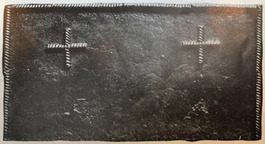 ? x ? mm
? x ? mmDescription: Rectangular shape; twisted rope edging (top and sides); upper centre, two evenly-spaced, medium-sized twisted rope crosses.
Notes: Formerly (1950) at Maidstone, Kent. Illustration from Schubert, 1950.
- Decoration tags:
- rectangular (shape)
- rope (edging)
- simple stamps
- apotropaic
- objects
Manufactured: in the late 16th to early 17th century possibly in the Weald area of England.
Current location:, not known.
Citation: Schubert, H. R., Aug 1950, ‘Old English Iron Firebacks’, Steel News, 2, 2, p. 8.
- Attached to series:
- Rope design firebacks
